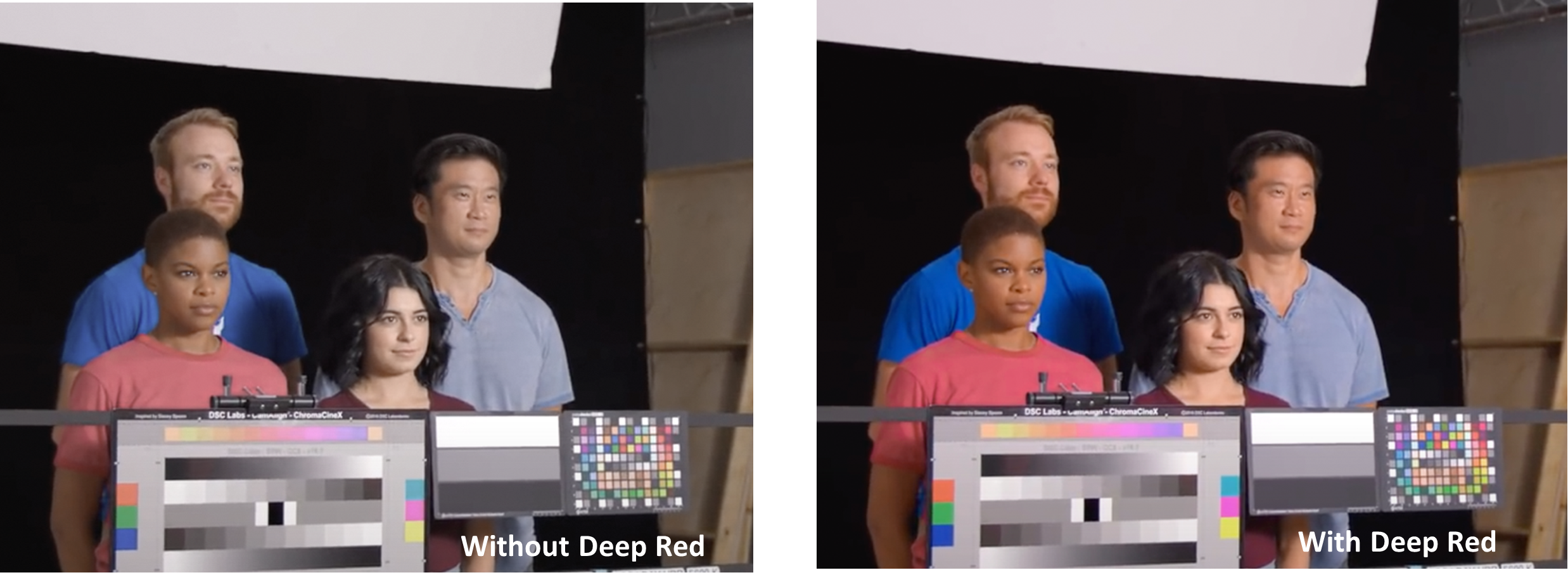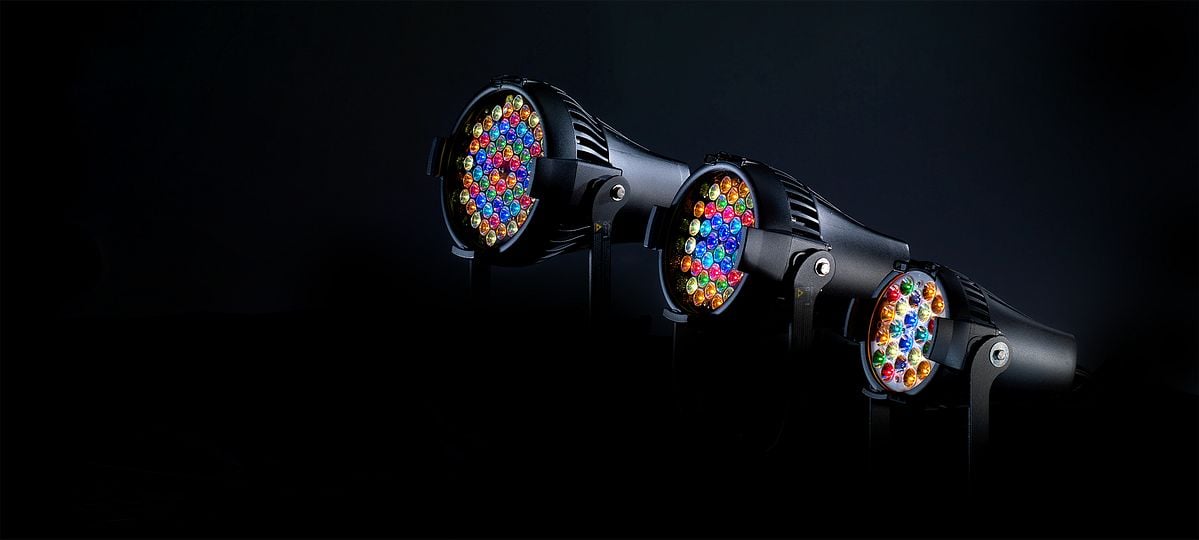In part one of An Array of Choices, we took a look at red, green, and indigo LEDs. In this second article, we’ll dig deeper into the library of additional colors available and what that means for color perception.
BROADBAND EMITTERS
LED technology is constantly developing, and phosphor-coated LEDs are common in all applications. It is this technology that allows for certain colors to exist – for example, white, lime, mint, and cyan are created using phosphors. Neither would the amber, lime, mint, cyan, or any of the other colors of LED exist either. By including broad-band emitters in the LED array, we can include greater portions of the spectrum in the light source.
As we take a look at the emitters used by different fixtures and manufacturers, we will also look at how these can contribute to the overall gamut and spectral power distribution (the technical bits) and also how these can help you to make beautiful lighting (the arty bits). Understanding how the different emitters contribute to the overall light quality will help to inform your choices when selecting luminaires for your next project.
BLUE
The arty bit: If we consider that most luminaires actually use an indigo emitter, then adding in a blue LED means that we are able to soften the color mix slightly and make magentas and lavenders that do not have that almost ultraviolet zing to them, bringing the colors more in line with the subtle jewel tones that filters were traditionally able to create. If your application is for lighting cycloramas, then you might favor the indigo emitter as you will be able to achieve more saturated ‘midnight blues,’ but some caution should be exercised here – overly saturated blues can be hard on an audience’s eyes and will often not respond well on camera. 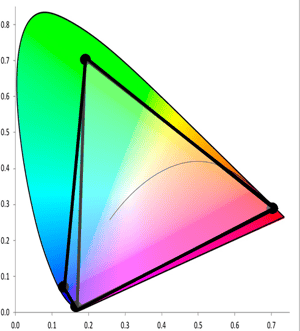
The technical bit: As we plot each new emitter point on the chromaticity diagram, we can see how the color gamut increases with each new addition. The blue LED (460 - 485 nm) may not immediately appear to make a huge difference, but indeed it does! This CIE color space is "non-uniform" - meaning distances here don't necessarily correspond to how large or small the perceived difference will actually be. Blue and indigo are very different visually! And the blue opens up all the soft sky blue hues that indigo is just too vibrant to nail. The blue emitter also enables better whites without the strong presence of the over-saturated indigo - which can sometimes cause objects to appear almost fluorescent. The blue emitter also helps to achieve cleaner whites at the higher end of the color temperature scale.
AMBER ![]()
The technical bit: The amber LED we use (600 - 615 nm) is a broad-band emitter, and in addition to adding nuance to the color mix, it contributes greatly to the adjustment of color temperature. The grey curved line shown on the CIE graph represents the blackbody locus – the curve that shows color temperature. The addition of the amber emitter has greatly increased the CT gamut making it easier to mimic the lower, warmer color temperatures. 
As you can see in the SPD, the amber emitter covers a broad portion of the spectrum. It is this wide band that increases the color gamut and allows a greater range within the blackbody curve.
The arty bit: If you know that you need to recreate the effect of fire- or candlelight, choosing a fixture that has amber as part of the array is essential. While you can arguably mix the same amber tones using just the red and green emitters, this will result in a light that is not very realistic due to the green content in the mix. The amber will also contribute to your being able to create beautiful sunrises and sunsets by giving you the finer control over the color temperature you need when trying to emulate the light nature provides for us. It also allows for the more subtle mixing of yellows, ambers, and yellow greens.
LIME 
The technical bit: The lime LED (550 - 560 nm) is extremely efficient, and as its frequency aligns with our eye’s peak sensitivity, it contributes significantly to the overall output of the luminaire. The lime emitter is a wonderfully broad-band emitter that fills in a large portion of the (previously) missing spectrum.

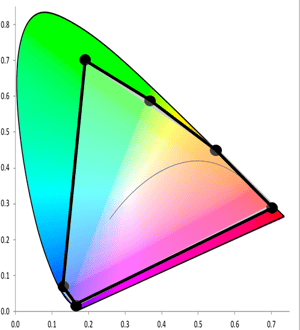
While on the CIE graph, it appears to not make a significant gamut difference, the impact on the z-axis (brightness) is huge. ETC was the first manufacturer to introduce the lime emitter in an entertainment fixture (Source Four LED Series 2 Lustr) in 2014, and its impact on the spectrum and color rendering properties of the light was phenomenal.
The arty bit: The lime can be a tricky color to work with, so having a console that understands this emitter and its contribution to the mix is certainly going to be helpful. We find adding the lime to almost any color that we mix, even at low intensities, adds an extra layer of depth and ‘rounds out’ the color, softening some of the huge spikes that additive mixing with LEDs can cause.
CYAN 
The number of fixtures that make use of this emitter is limited to a few manufacturers, but for work on camera or in instances where skin tone rendering is important, having this as a part of the array is definitely beneficial.
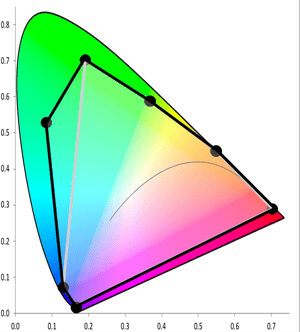
The technical bit: use of the cyan LED (500 - 525 nm) helps to widen the color gamut even further, and of all the emitters in this post, the cyan is arguably the one that makes the most significant improvement to the overall color gamut.
The arty bit: This is a really useful addition to the LED array due not only to its contribution to the rendering of skin tones but also to the depth it adds to the blues and greens. Your nighttime scenes and moonlight filtering through the leaves or through the windows will take on a more lifelike quality.
DEEP RED 
In early 2020, ETC introduced the deep red LED. This emitter fills in a missing portion of the spectrum, allowing for richer ambers, oranges, and reds, resulting in a wider color gamut.
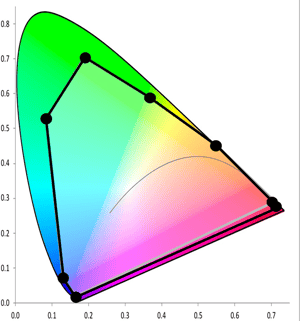 The technical bit: The deep red emitter (660 nm) widens the gamut even further. It is worth noting that although the apparent change to the gamut may seem small, the actual contribution to the overall spectrum and rendering capabilities of the luminaire is huge. The deep red contributes significantly to the rendering of skin tones – across all ranges of skin tone, a universal skin-tone tool if you will. The deep red makes the standard red look quite orange by comparison.
The technical bit: The deep red emitter (660 nm) widens the gamut even further. It is worth noting that although the apparent change to the gamut may seem small, the actual contribution to the overall spectrum and rendering capabilities of the luminaire is huge. The deep red contributes significantly to the rendering of skin tones – across all ranges of skin tone, a universal skin-tone tool if you will. The deep red makes the standard red look quite orange by comparison.
The arty bit: This is the color you probably did not know you were missing. Recreating the light of the ‘golden hour’ is easier and made more realistic with the addition of a deep red emitter. Firelight, candlelight, and low-level sunlight are all enhanced by this emitter. On its own, it is not terribly bright, but this does mean that you can layer it into most of your colors to get the reds to ‘pop’ without altering the color point you have selected. If you are trying to emulate the characteristics of a tungsten source, then the deep red goes a long way to filling in the portions of the spectrum you have been missing to make this possible.
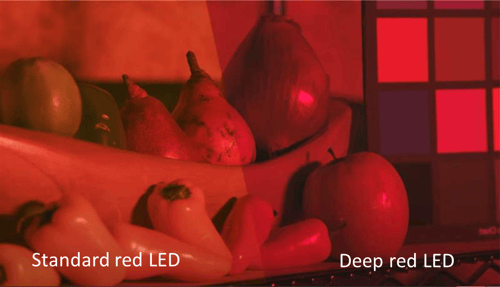
If you are working in film, the presence of the deep red rounds out the color spectrum and provides a greater amount of digital lighting information at the time of shooting, meaning that you need to spend less time adjusting colors in post-production. The more digital information you have available at the time of recording means the more power and control you have over the manipulation of the color and the rendering. Being able to have full-color control at the time of shooting can save you time and money by reducing the amount of post-production time required.

A tungsten lamp warms up as it dims down, resulting in portions of the visible spectrum that we have not been able to recreate accurately using LED until now. Tungsten sources have long been the preferred light when lighting actors as the natural bias towards the red portions of the spectrum are flattering for all skin tones. The inclusion of the deep red emitter brings back the vitality and depth to skin tones that have been missing in LED arrays. 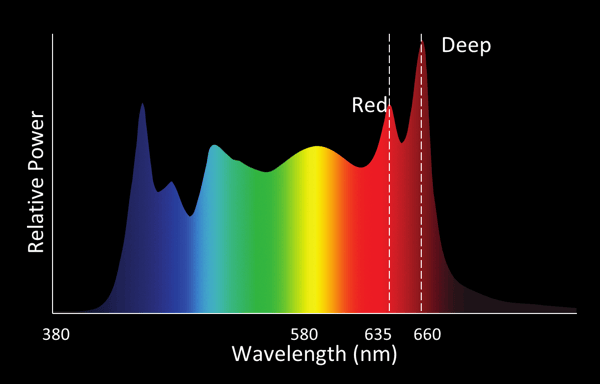
 Knowing how each of the different emitters can contribute to the light quality will help you to make an informed choice of fixture when planning your next project. Depending on your requirements, you may choose to favor one array over another. Ensuring that your selected fixture has at least some of the broad-band LEDs in its array will offer peace of mind that you will be able to achieve acceptable color rendering. They say: “Less is more,” but in the case of an LED array, if less was more, just imagine how much more “more” gives you!
Knowing how each of the different emitters can contribute to the light quality will help you to make an informed choice of fixture when planning your next project. Depending on your requirements, you may choose to favor one array over another. Ensuring that your selected fixture has at least some of the broad-band LEDs in its array will offer peace of mind that you will be able to achieve acceptable color rendering. They say: “Less is more,” but in the case of an LED array, if less was more, just imagine how much more “more” gives you!
This post is a part of a series. Check out the rest of the content at the links below.
Article written by: Wendy Luedtke and Declan Randall, a freelance lighting, set and projection designer for 23 years before he joined ETC as Training Program Coordinator in 2018. www.declanrandall.com


